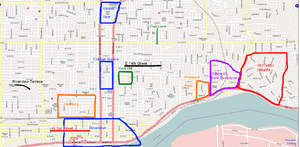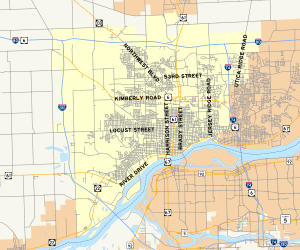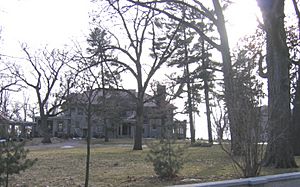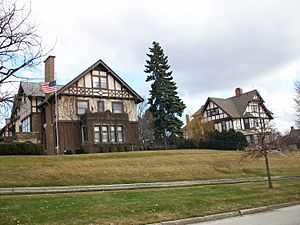Neighborhoods of Davenport, Iowa facts for kids
Davenport, Iowa, is a city in the United States with many interesting neighborhoods. Some of these neighborhoods are very old, dating all the way back to the 1840s! The city has divided itself into five main areas: downtown, central, east end, near north, and northwest and west end. As you explore these areas, you'll see many different styles of buildings. Some popular styles include Victorian, Queen Anne, and Tudor Revival. Many of the first people to live in these old neighborhoods were German settlers.
Contents
Downtown Davenport: Where the City Began
Downtown Davenport is right next to the mighty Mississippi River. It's bordered by the river to the south, railroad tracks to the east and north, and Warren Street to the west. This area started growing a lot in the 1840s and 1850s. Back then, most buildings were small, one- or two-story wooden structures.
Later, in the 1880s and 1890s, the city became more successful. This led to bigger and fancier commercial buildings. The first department store, a five-story brick building, was built during this time. New building methods and elevators allowed buildings to become much taller! The western part of downtown also started to have more homes, mostly apartments.
Downtown Davenport is home to the two tallest buildings in the Quad Cities area. These are the Wells Fargo Bank Building, which is 255 feet (78 meters) tall, and the Mid-American Energy Building, which is 220 feet (67 meters) tall. Other tall buildings include the 11-story Blackhawk Hotel, the 150-foot (46-meter) Kahl Building, and the Davenport City Hall. There's also the Davenport Motor Row and Industrial Historic District, which used to be an area for small factories and businesses.
Central Neighborhoods: A Mix of History
The central part of Davenport has several unique neighborhoods, each with its own story.
West Third Street: German Roots
The West Third Street neighborhood stretches from Scott Street to Myrtle Street. It's special because of the many German-American families who first lived here. Most residents were working-class people. The heart of this neighborhood was Washington Square. This block was set up by Antoine LeClaire, one of the city's founders. It was a lively place for German beer gardens, music, celebrations, and a welcoming spot for new German immigrants.
Hamburg: Beautiful German Homes
Hamburg is located northwest of Downtown, between Fifth and Ninth Streets and Ripley and Vine Streets. This neighborhood has some of the most beautiful old buildings from the German settlement days. Hamburg sits on hills that look down over Downtown and the river. It was a popular place for important German families to live. Most buildings here are homes, with very few shops or churches. The first houses were small cottages in the Greek Revival style. You can also find Victorian, Gothic Revival, Italianate, Second Empire, and Queen Anne style homes here.
Cork Hill: Irish and American Settlers
Cork Hill is about one square mile of land east of the original town. It was also planned by Antoine LeClaire between the 1840s and 1880s. This area was home to LeClaire himself, his family, and many Irish and American settlers. It has many large and medium-sized houses built close together. The beautiful Sacred Heart Cathedral is also located here. The houses show off styles like Italianate, Queen Anne cottage, Georgian, and Colonial Revival.
East Fourteenth Street: Middle-Class Homes
East Fourteenth Street has 67 houses along Fourteenth Street, from Pershing Street to Arlington Avenue. These homes were built between the 1840s and 1870s. This neighborhood was home to many middle-class Irish immigrants and Americans. The houses are quite large and range from Victorian to Classical Revival styles. Almost all of them are made of wood. Important business owners, factory leaders, and professionals lived here originally.
College Square: Education and Homes
College Square is north of Downtown, from Tenth to Fifteenth Street and Brady Street to Harrison Street. Two blocks on Harrison Street have houses from the mid-1800s. Another two blocks are home to large schools and religious buildings, including the Palmer College of Chiropractic campus. Most houses in this neighborhood were built from 1860 to the early 1900s. Harrison and Main streets have become more commercial over the years, while the west side of Brady Street still has mostly homes.
East Neighborhoods: River Views and Parks
The east side of Davenport offers stunning views and lovely parks.
Bridge Avenue: Historic Residences
The Bridge Avenue historic area goes from River Drive, along the Mississippi River, up a hill to East Ninth Street. This neighborhood has 14 houses on the southern end of Bridge Avenue. Most of these homes were built between 1870 and 1910. One of the most important houses was built by Ambrose Fulton, who was very important in Davenport's early days and its industrial growth. He was a strong supporter of the new town.
McClellan Heights: Grand Homes and Winding Roads
McClellan Heights is the biggest neighborhood in the east end. It covers a large area of 400 acres (1.6 square kilometers). It stretches from Jersey Ridge Road to the Bettendorf city limits, and from River Drive to Middle Road. About 400 houses make up McClellan Heights, built between 1905 and 1940. The land has many hills and valleys, so the streets curve and wind, creating unique lots. Four very large mansions were built here before World War I, attracting wealthy residents. House styles include American Craftsman, Prairie, American Foursquare, Colonial Revival, and Georgian. Many Dutch and New England immigrants settled here. The houses and a few brick streets are still in great condition.
Prospect Park: Park-Focused Living
Prospect Park is a small neighborhood on the western edge of the Village of East Davenport. It runs along Mississippi Street from Eleventh Street down to River Drive and a block east along Prospect Drive and Prospect Terrace. It was developed from 1895 to 1910. This neighborhood is one of many in Davenport built around a park. The houses in Prospect Park are very large and sit on big lots. They are built in the late Queen Anne, Neoclassical, and Tudor Revival styles. Many important people lived here, like contractors, doctors, and lawyers. The great view of the river kept this neighborhood popular even after the first families moved away. Unlike some other old neighborhoods, Prospect Park still has mostly single-family homes.
The Village of East Davenport: Historic Charm
The Village of East Davenport (often called The Village) is a neighborhood that dates back to the 1850s. It was first known as "Stubb's Eddy." The Village was started in 1851 to support the logging industry. The city of Davenport officially took it over in 1857. It grew in three main stages: after the American Civil War, when many homes were built; from 1890 to 1915, when large mansions were built on the hillsides with river views; and around the 1900s, at the far east end of the neighborhood. The houses in The Village were built along the natural curves of the land, not in the straight grid pattern used in the rest of the city.
Today, The Village has both homes and businesses, mostly small, unique shops. It's bordered by Judson Street to the west, Kirkwood Boulevard to the north, Jersey Ridge Road to the east, and River Drive to the south. The commercial buildings are in the lower, southern part of the neighborhood, while homes are on the hillside to the north. Lindsay Park is in the southeast corner. This park was used for parades by soldiers from Camp McClellan during the Civil War. Today, the park has playgrounds and baseball fields, and it offers a nice view of the river.
Near North Neighborhoods: Growing with Transportation
Around the early 1900s, Davenport started to grow along its main roads and streetcar lines. Areas like Locust Street, Brady Street, and Harrison Street developed during this time.
Columbia Avenue: Apartment Living
Columbia Avenue is a neighborhood located north and west of Vander Veer Botanical Park. This area is entirely residential and has brick apartment buildings built between 1930 and 1939. It is one of the city's smallest historic districts. It's special because it mainly has apartment buildings, unlike other historic areas. The neighborhood has 19 apartment buildings with four to six units each, built in the 1930s, plus two similar buildings from the 1950s.
Oak Lane: Early 1900s Development
Oak Lane is a neighborhood along Oak Lane from High Street south to Locust Street. It has 27 middle-class houses built between 1900 and 1910 by Amos Cutter, a local real estate developer. This neighborhood is a good example of how new areas were planned and built in Davenport in the early 20th century.
Vander Veer Park: Homes Around a Green Space
Vander Veer Park consists of houses that surround Vander Veer Botanical Park. It's bordered by Central Park Avenue to the north, Brady Street to the east, Lombard Street to the south, and Harrison Street to the west. The houses were built between 1895 and 1915 and are in the Queen Anne and Tudor Revival styles. A church and an outing club anchor the southern part of the neighborhood. The park was first called Central Park, like the one in New York City, and was once the site of the Scott County Fairgrounds. It was later renamed Vander Veer to honor an early Davenport park commissioner. Developing Vander Veer Park was the first major effort to make areas outside of downtown beautiful.
Northwest and West End Neighborhoods: Post-Civil War Growth
Northwest Davenport grew after the Civil War, especially around Locust Street, Marquette Street, and Washington Street. Many working-class German families lived here. The area was planned in the 1850s, and a lot of building happened in the 1870s. Most houses were one-and-a-half to two-story homes in the American Foursquare and simplified Queen Anne styles. The area where three streets meet, called "five-points," had most of the shops. Many of the original buildings have been changed or replaced, so this historic area looks different now.
Riverview Terrace: Hilltop Views
Riverview Terrace is a neighborhood with 24 houses and a 3-acre (12,000 square meter) park. Riverview Terrace runs along Clay Street from Fillmore Street northwest to the edge of the old Marycrest International University. On the south side is Riverview Terrace Park, which was first called Lookout Park. It's on a large, steep hill. The area around the park has large Italianate, Georgian, and Federal-style houses. Beyond the park, you'll find smaller houses and brick streets.









